If you’ve never used resistance bands before, it can be puzzling to decipher what the weight means on each band. If a resistance band is quoted at 30-60lbs, then is it 30lbs or 60lbs? How could it possibly be both?
The weight on a resistance band indicates the tension it provides at the maximally stretched state. For example, a band that is quoted to 60lbs means it produces 60lbs of resistance when fully stretched. The same band can also produce less resistance in a partially stretched state.
I’ve gone through many sets and equally as many brands in my 5-year resistance band journey.
Below, I’ll explain exactly what the tension levels mean and how you can learn to decode the weight charts given by manufacturers!
- Don't Want The Headache Of Having To Choose The Ideal Band Weight?
- Why Resistance Bands Have A Variable Weight Range
- How Weights Are Assigned To A Resistance Band
- How Does Resistance Band Weight Work?
- Why Some Resistance Bands Have A Heavier Weight Than Others
- What Are The Heaviest And Lightest Resistance Bands?
- Which Resistance Band Weight And Size Should You Get?
- Conclusion
Don’t Want The Headache Of Having To Choose The Ideal Band Weight?
I use and recommend the Undersun resistance bands.
They’re extremely durable (protected by a lifetime warranty) and come in a set of 5 bands each of which has different tensions.
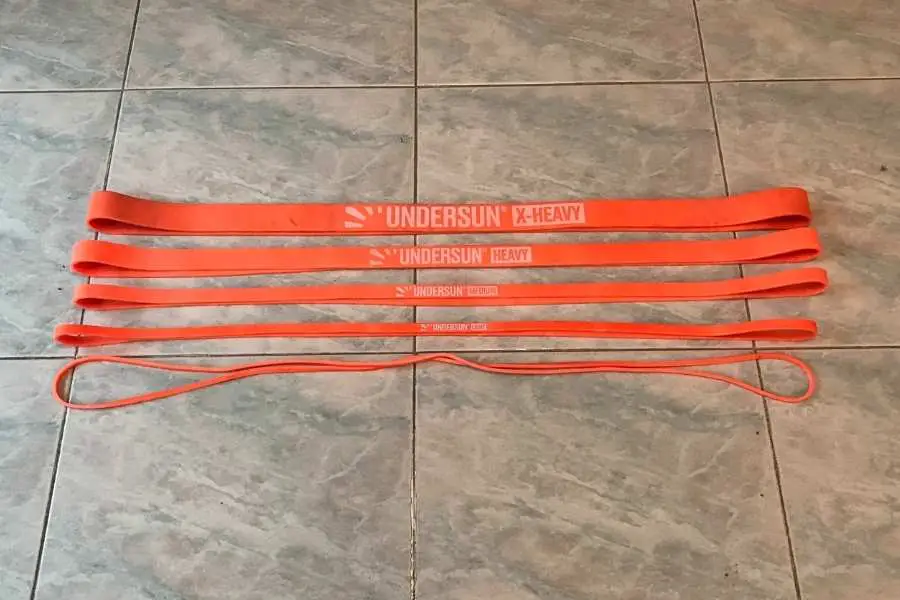
They’re an affordable set of bands and provide enough tension to take a beginner all the way to the intermediate-advanced stages of training.
That means you don’t have to worry about choosing the ideal band weight (or fret about choosing the wrong one in fact!).
Why Resistance Bands Have A Variable Weight Range
Resistance bands are assigned a weight range by their variable tension. As the band stretches, it produces more resistance. Therefore manufacturers need to quote a tension range to accurately describe the amount of weight offered by each band.
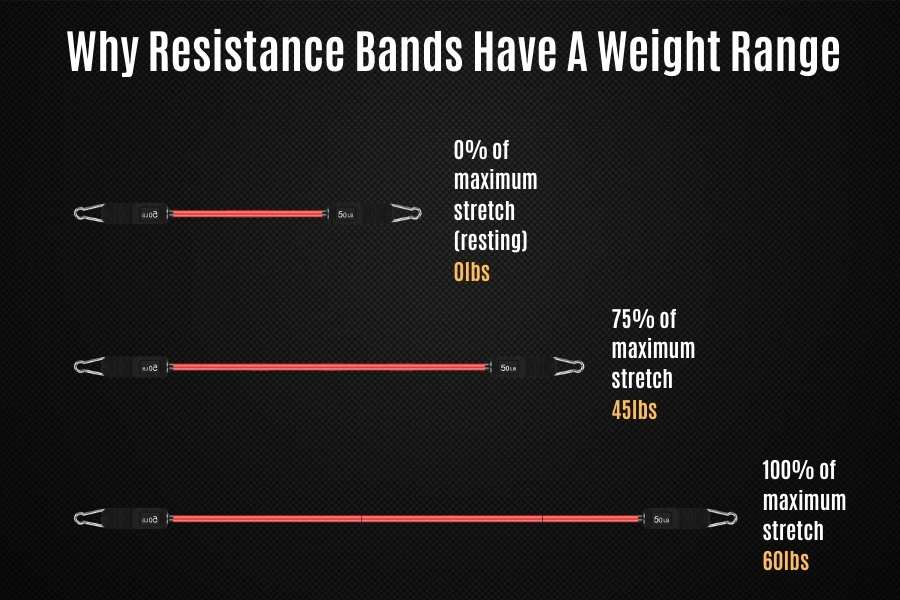
If you think about it, a resistance band is literally a giant elastic band.
And if you’ve ever stretched an elastic band, you’ll know what variable resistance feels like.
There is very little tension in the resting state. But the tension increases only slightly as you stretch it. And if you stretch it a lot, then the tension increases a lot.
This “tension profile” is what manufacturers are referring to when they quote the weight range on their resistance bands.
To understand this a bit better, it helps to know how a manufacturer measures the tension in a resistance band (see next)
How Weights Are Assigned To A Resistance Band
A weight is assigned to resistance band using an anchor measurement method. One end of the resistance band to be measured is anchored to a secure fitting whilst the other end is fixed to a measuring scale. This allows the tension generated by the stretching band to be measured.
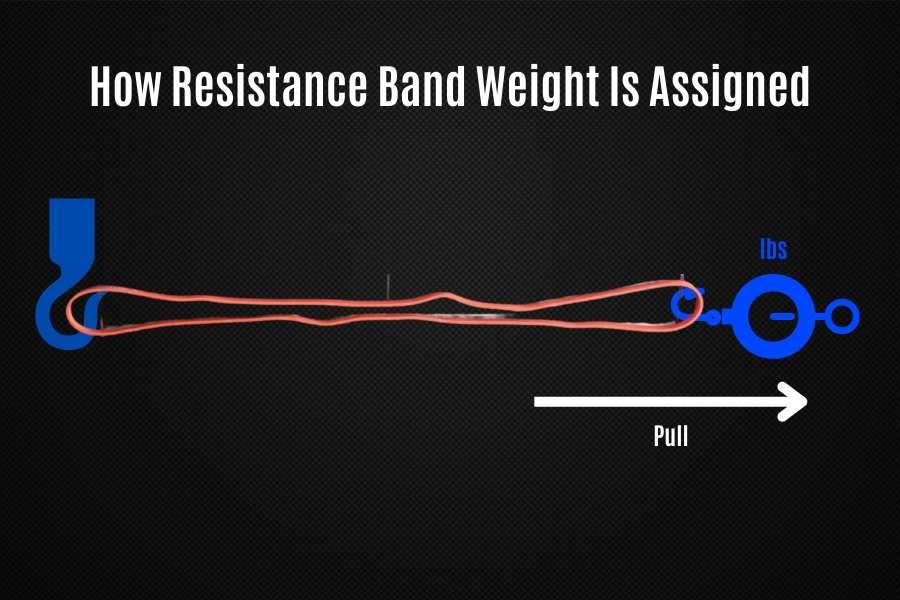
I contacted the guys at Undersun Fitness– a resistance band company- to find out exactly how they assign a weight to their resistance bands.
Here’s how a manufacturer measures a resistance band’s tension, in more detail:
- The resistance band is firmly secured to an anchor.
- The other end of the band is attached to a movable scale.
- The scale is pulled away from the band to stretch it.
- The process stops once the band has been stretched to its safest limit.
- Tension force is measured at various points whilst being stretched.
Usually, a resistance band can safely stretch between 2-3x their resting length.
Any more than this, and the risk of the resistance band snapping increases significantly.
Of course, each brand is different. And some resistance bands can be stretched less and some more.
So be careful and do your research if you’re pushing your bands to their limits!
How Does Resistance Band Weight Work?
The perceived weight from a resistance band is generated through an external force that acts opposite to the direction of muscle contraction. This allows a user to push or pull on one or more bands to work their muscles. Heavier bands generate a greater amount of resisting force.
Force profiling studies show that the tension generated is proportional to the stretch.
In other words, the longer a band stretches the greater the force generated (this is what confers resistance bands their unique benefits).
And if we go back to the elastic band example, we can see why the weight on resistance bands behaves like this.
Generally speaking, the tension profile of a resistance band behaves similar to the weight calculator chart below:
| Percent Of Maximum Stretch | Resistance Produced |
|---|---|
| 0% (resting) | None (resting |
| 25% | Minimum quoted resistance |
| 50% | 0.50x of maximum quoted resistance |
| 75% | 0.75x of maximum quoted resistance |
| 100% | 1.00x of maximum quoted resistance |
Here, you can see the variable resistance properties described previously.
As the resistance band stretches further, the weight also increases.
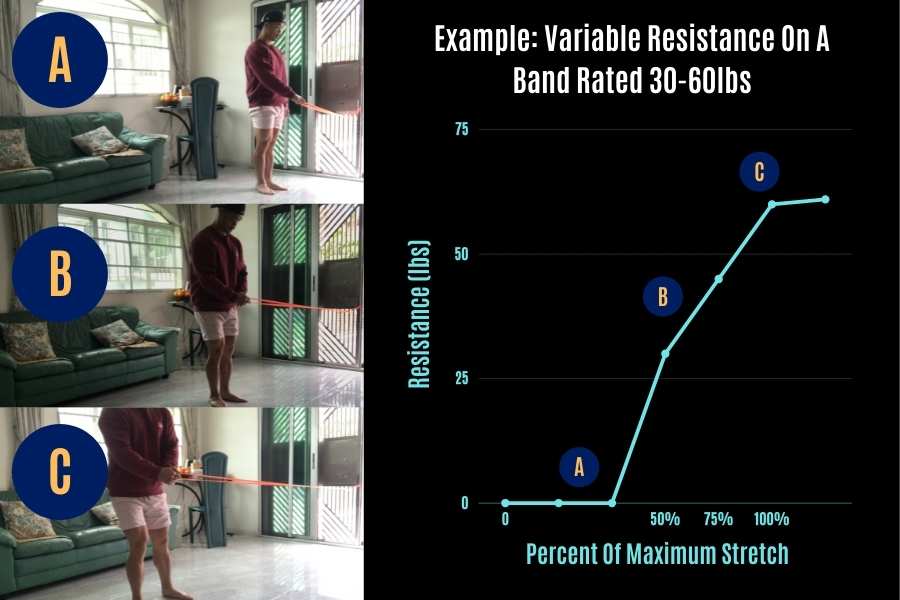
Now let’s study this in more detail using an Undersun Fitness Medium band example which is rated at 30-60lbs.
This simply means the band provides 30-60lbs of resistance depending on how far it is stretched, as follows:
- 25% of max stretch = 30lbs.
- 50% of max stretch = 30lbs.
- 75% of max stretch =45lb.
- 100% Max stretch = 60lbs.
You’ve probably noticed that the band produces most of its tension when it’s close to maximum stretch (not linear).
That’s because- just like an elastic band- it’s easy to stretch a resistance band at the start, but this becomes increasingly harder as the band approaches its stretching capacity.
You can check out my other article if you’re interested in learning more about how a resistance band works.
Why Some Resistance Bands Have A Heavier Weight Than Others
Now you may be wondering why different band weights and tensions even exist?
You could probably already make a good guess as to why.
But if you don’t know, then here are the 4 main reasons why some resistance bands have a heavier weight than others:
- Small and large muscle groups require different resistances. A small muscle like the bicep generally needs a lighter band for an effective workout, compared to a large muscle like the pecs.
- Compound and isolation movements require different resistances. Isolation lifts like the band curl work a single muscle at a time and therefore require less weight compared to compound lifts like the band press which allow you to lift heavier weights.
- Different training levels require different resistances. The longer you’ve been resistance training the heavier the resistance you generally need.
- Different training goals require different resistances. Those looking to build muscle generally require heavier bands compared to those who are training for general fitness.
Considering all 4 factors, this is why manufacturers make their resistance bands for different weights!
If you’re trying to plan the perfect band workout, you might not want to miss my other post which explains how many reps and sets you should be doing for resistance bands!
What Are The Heaviest And Lightest Resistance Bands?
If different resistance bands have different weights, then what are the heaviest and lightest resistance bands out there?
Speaking from experience, an average set of resistance bands has multiple bands that range from as little as 10lbs to as high as 150lbs of rated resistance.
Bands in a set are usually color-coded or labeled in some other way.
These sets are great for a beginner to get to the intermediate-advanced stages of resistance band training.
And this is the equivalent of around 2-4 years of strength progression.
Which Resistance Band Weight And Size Should You Get?
When we consider all that has been said in this post, you may now be wondering what resistance band size to get.
Here are the resistance band weights I would recommend for beginners:
| Bodyweight | Ideal Band Weight For Male Beginners | Ideal Band Weight For Female Beginners |
|---|---|---|
| 90lbs | 40-60lbs | 20-30lbs |
| 120lbs | 60-80lbs | 30-40lbs |
| 150lbs | 80-100lbs | 40-50lbs |
| 180lbs | 100-120lbs | 50-60lbs |
| 210lbs | 120-140lbs | 60-70lbs |
These recommendations will allow you to work your muscles sufficiently for most exercises (including compound and isolation-type movements).
But bear in mind that these are just general recommendations.
In reality, you should consider your fitness level and exercise choice when choosing the ideal resistance band tension.
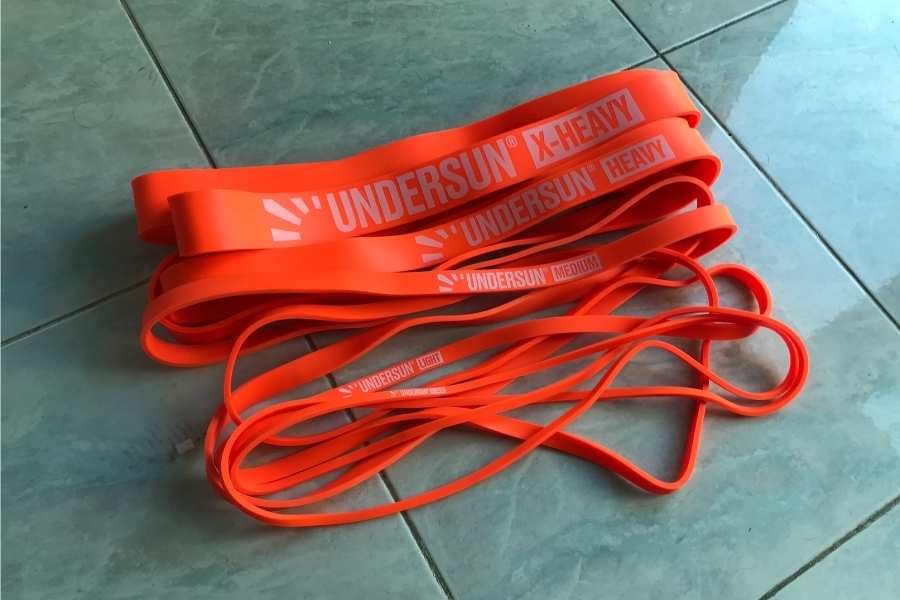
My best advice is to get a resistance band set that goes from 10-100lbs.
This gives you access to all the resistance levels you need currently as well as in the future (without the headache of choosing individual bands).
Having used the Undersun resistance band set, for just over 2 years now, I can fully recommend them.
I could also recommend you, other models. After all, I’ve tried half a dozen brands in the past,
But honestly, none even come close to the Undersuns!
They’re worth every cent!
New to band workouts? You might be interested in my other article which explains how long a resistance band workout should last!
Conclusion
I’ve explained what the weight means on resistance bands.
Manufacturers often give band weight, also known as tension or resistance, as a range (e.g. 30-60lbs).
This indicates how much resistance that particular band produces when stretched.
The maximum weight indicates how much tension is produced when the band is stretched to 100% of its safest limit.
And the minimum weight indicates how much tension is required to begin stretching the band from its resting state.
What resistance band weight will you be getting?
Feel free to send me a message if you have any questions! You can find my details on the “contact us” page.
You may also be interested in the downloadable Kalibre Blueprint PDF which details exactly how I gained 40lbs of lean muscle (it’s 100% free!). It details the exact exercises and nutrition (with printable worksheets) I used to go from skinny to ripped!
Thanks for reading guys!
Peace Out,
Kal
(Biochemistry BSc, Biomedical Sciences MSc, Ex-Skinny Guy)


